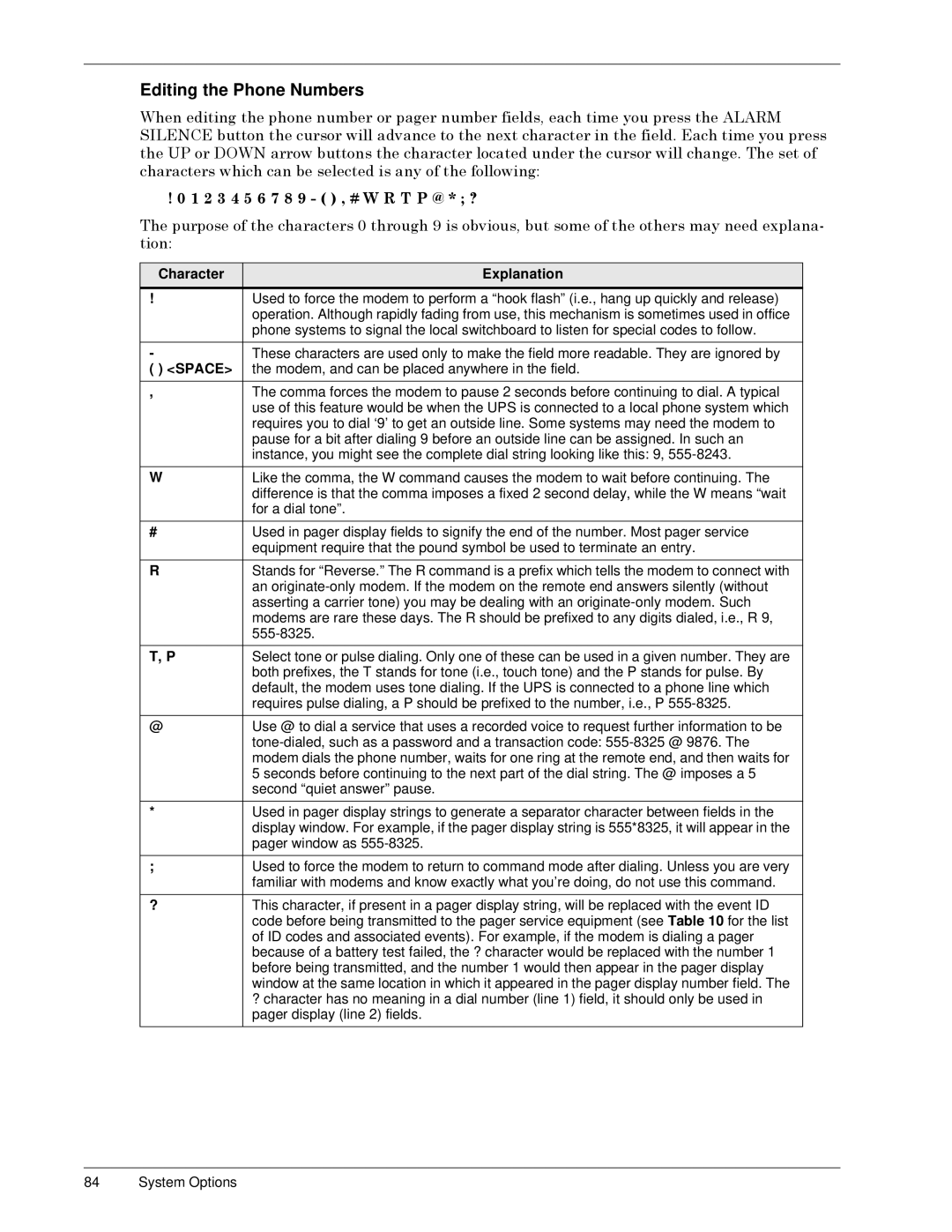
Editing the Phone Numbers
:KHQýHGLWLQJýWKHýSKRQHýQXPEHUýRUýSDJHUýQXPEHUýILHOGVñýHDFKýWLPHý\RXýSUHVVýWKHý$/$50ý 6,/(1&(ýEXWWRQýWKHýFXUVRUýZLOOýDGYDQFHýWRýWKHýQH[WýFKDUDFWHUýLQýWKHýILHOGïý(DFKýWLPHý\RXýSUHVVý WKHý83ýRUý'2:1ýDUURZýEXWWRQVýWKHýFKDUDFWHUýORFDWHGýXQGHUýWKHýFXUVRUýZLOOýFKDQJHïý7KHýVHWýRIý FKDUDFWHUVýZKLFKýFDQýEHýVHOHFWHGýLVýDQ\ýRIýWKHýIROORZLQJã
üýíýìýëýêýéýèýçýæýåýäýðýõýôýñýúý:ý5ý7ý3ý#ýóýâý"
7KHýSXUSRVHýRIýWKHýFKDUDFWHUVýíýWKURXJKýäýLVýREYLRXVñýEXWýVRPHýRIýWKHýRWKHUVýPD\ýQHHGýH[SODQDð
WLRQã
Character | Explanation |
|
|
! | Used to force the modem to perform a “hook flash” (i.e., hang up quickly and release) |
| operation. Although rapidly fading from use, this mechanism is sometimes used in office |
| phone systems to signal the local switchboard to listen for special codes to follow. |
|
|
- | These characters are used only to make the field more readable. They are ignored by |
( ) <SPACE> | the modem, and can be placed anywhere in the field. |
|
|
, | The comma forces the modem to pause 2 seconds before continuing to dial. A typical |
| use of this feature would be when the UPS is connected to a local phone system which |
| requires you to dial ‘9’ to get an outside line. Some systems may need the modem to |
| pause for a bit after dialing 9 before an outside line can be assigned. In such an |
| instance, you might see the complete dial string looking like this: 9, |
|
|
W | Like the comma, the W command causes the modem to wait before continuing. The |
| difference is that the comma imposes a fixed 2 second delay, while the W means “wait |
| for a dial tone”. |
|
|
# | Used in pager display fields to signify the end of the number. Most pager service |
| equipment require that the pound symbol be used to terminate an entry. |
|
|
R | Stands for “Reverse.” The R command is a prefix which tells the modem to connect with |
| an |
| asserting a carrier tone) you may be dealing with an |
| modems are rare these days. The R should be prefixed to any digits dialed, i.e., R 9, |
| |
|
|
T, P | Select tone or pulse dialing. Only one of these can be used in a given number. They are |
| both prefixes, the T stands for tone (i.e., touch tone) and the P stands for pulse. By |
| default, the modem uses tone dialing. If the UPS is connected to a phone line which |
| requires pulse dialing, a P should be prefixed to the number, i.e., P |
|
|
@ | Use @ to dial a service that uses a recorded voice to request further information to be |
| |
| modem dials the phone number, waits for one ring at the remote end, and then waits for |
| 5 seconds before continuing to the next part of the dial string. The @ imposes a 5 |
| second “quiet answer” pause. |
|
|
* | Used in pager display strings to generate a separator character between fields in the |
| display window. For example, if the pager display string is 555*8325, it will appear in the |
| pager window as |
|
|
; | Used to force the modem to return to command mode after dialing. Unless you are very |
| familiar with modems and know exactly what you’re doing, do not use this command. |
|
|
? | This character, if present in a pager display string, will be replaced with the event ID |
| code before being transmitted to the pager service equipment (see Table 10 for the list |
| of ID codes and associated events). For example, if the modem is dialing a pager |
| because of a battery test failed, the ? character would be replaced with the number 1 |
| before being transmitted, and the number 1 would then appear in the pager display |
| window at the same location in which it appeared in the pager display number field. The |
| ? character has no meaning in a dial number (line 1) field, it should only be used in |
| pager display (line 2) fields. |
|
|
84 System Options
